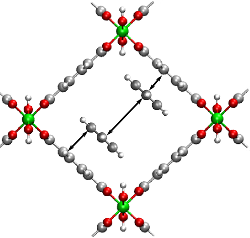Accurate parameterization of non-bonded interactions in nanoporous materials
Accurate parameterization of non-bonded interactions in nanoporous materials
Promotor(en): T. Verstraelen, V. Van Speybroeck /15_MODEV02 / Model and software developmentWhen two molecules approach each other without forming chemical bonds, they interact through non-bonded interactions. These non-bonded interactions can be divided into several parts. The electrostatic interactions act between permanently charged species and are governed by the Coulomb interaction. Pauli repulsion is a short-ranged repulsive interaction originating from the quantum mechanical Pauli exclusion principle. Induction arises from the electrostatic interaction between a permanent charge distribution and a charge distribution induced by the permanent distribution. Dispersion is a long-ranged attraction due to the correlated dynamics of distant electrons. To compute the interaction energy of a non-bonded dimer, one can not rely on common quantum mechanical (QM) methods such as Hartree-Fock (HF) or Density Functional Theory (DFT). The main reason is their lack of sufficient accuracy. For example, DFT is known to seriously underestimate the dispersion energy, which is a major contribution in many systems. Therefore, one is forced to use more accurate, but much more expensive methods such as Coupled Cluster (CC), Symmetry Adapted Perturbation Theory (SAPT) or Complete Active Space Self Consistent Field (CASSCF). Furthermore, most of these methods, except SAPT, do not allow to compute the different contributions to the total interaction energy, which can be very useful to understand the processes one is interested in on a molecular level.

For large systems, i.e. more than 100 atoms, the accurate QM methods are not feasible, not even on high-performance supercomputers. As an alternative, so-called force fields (FFs) can be used, in which the interactions between atoms in molecules are approximated directly without solving the electronic structure problem. Instead, the interaction is modeled by means of a priori proposed mathematical functions of the internal coordinates (chemical bonds, bending angles, dihedrals angles, distances between non-bonded atoms, ...). Usually, force fields have an empirical mathematical form with many adjustable parameters that must be fixed before the model can be used. The development of such a force field model is in practice far from trivial, yet they are highly needed in many simulations studies ranging from bio-engineering to materials science and chemical engineering.
Problem statement and goal An FF is usually divided into two parts: a covalent part and a non-bonded part. A new method has already been developed at the CMM and implemented in a Python code (QuickFF) to construct the covalent part, i.e. the part describing chemically bonded atoms. In this work, we will focus on the non-bonded part of the force field. Much progress has also been made regarding the non-bonded part and a first model, which includes the separation into all contributions mentioned above, is available. This model will serve as a starting point for this master thesis. However, the model requires further testing and tweaking for the intended systems of this proposal. The goal of this thesis is to pinpoint the weaknesses of the current model, extend the model with extra terms or tune the existing terms to increase the accuracy and validate the propositions on the suggested applications (see below).
To evaluate the model, two applications are envisioned. By expanding the mechanical equation of state of a gas (pressure as function of density and temperature) as function of density, one arrives at the virial expansion. The corresponding expansion coefficients (i.e. the virial coefficients) can be computed in molecular simulations and compared directly with experiment. However, they also allow to investigate more subtle effects such as the importance of many-body interactions. A second application is the adsorption of guest molecules (benzene, carbon dioxide, water, ...) in nanoporous materials such as zeolites and Metal-Organic Frameworks (MOFs). MOFs are a recent class of materials in which metal-oxide clusters (e.g. Zn4O) are connected by means of organic linkers (e.g. O2C-C6H4-CO2). This results in a 3D periodic framework (crystalline) with nanoscaled pores (nanoporous). In some cases, this 3D framework is rather flexible and can undergo large volume variations (up to 40%), this effect is called breathing. The adsorption of guest molecules in these MOFs is governed by the non-bonded interactions discussed above and will hence be described using the FF constructed in this master thesis. These adsorption processes are extremely important for various promising applications of these MOFs such as carbon capture, gas detection, gas separation, gas storage, nanoscale shock absorbers, ... To investigate the adsorption processes, the student will be able to use a thermodynamic model recently developed at the CMM. This model requires input from molecular simulations that use the FF constructed in this master thesis. For example, the computed virial expansion coefficients can be used as input. As a result, one can predict the loading and the possible volume variations of the flexible frameworks.
Multiple aspects of molecular modeling will be important in this thesis, ranging from theoretical development (extending the non-bonded model) to implementation (python programming), computational work (evaluating the existing non-bonding model) and physical interpretation (interpretation of the results of the practical applications). Programming skills will be transferred if necessary.
- Study programmeMaster of Science in Engineering Physics [EMPHYS], Master of Science in Physics and Astronomy [CMFYST]ClustersFor Engineering Physics students, this thesis is closely related to the cluster(s) nano, modeling, fundamentsKeywordsQuantum mechanics, Force fields, van der Waals, Nanoporous materials, Adsorption

